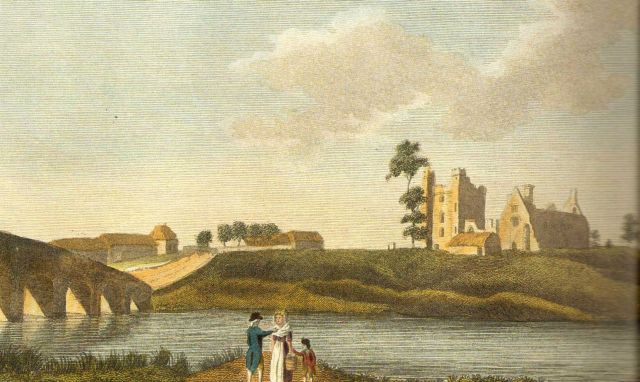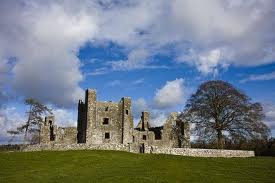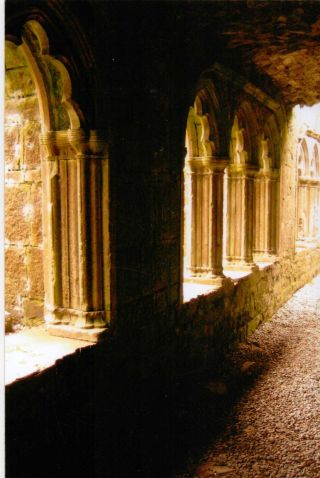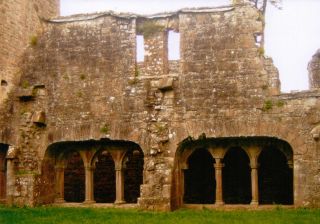Bective

18th century print of Bective Abbey (from Grose's, Antiquities of Ireland)
The ruins of Bective Abbey are to be found on the west bank of the River Boyne, about four miles from Navan on the road to Kilmessan.
It was a Cistercian Abbey, the first daughter house of Melifont. It was founded in 1147 by Murchard O’Melaghlin, King of Midhe, and was dedicated to the Blessed Virgin Mary.
In the late 12th or 13th century the Abbey was entirely rebuilt. In 1195 Hugh de Lacy’s headless body was reinterred at the Abbey, his head going to St. Thomas' Abbey, Dublin. (Eventually, the head and body were reunited and reinterred in St. Thomas' in Dublin)
 In its day, Bective Abbey was very powerful and the abbot was ex efficio one of the spiritual lords of parliament.
In its day, Bective Abbey was very powerful and the abbot was ex efficio one of the spiritual lords of parliament.
By the 15th century however, a decline had set in and the buildings had to be remodelled on a
significantly reduced scale.
Of the original O’Melaghlin Abbey, nothing at all survives.
Of the 12th – 13th century buildings there remain the chapter house with central column, part of the west range and fragments of the aisled cruciform church. In the 15th century the church was shortened on the west side, the aisles removed, new south and west ranges built inside the lines of the old cloister, and a smaller cloister erected.
The Abbey was dissolved by Henry VIII in 1536, after which it was turned into a fortified mansion by Thomas Agard, the civil servant who took over its lease. The possessons of the abbey at this time included about 1600 acres of land, a water mill and a fishing weir on the Boyne.

The south and west alleys of this latest cloister (left and below) survive
with interesting details on the arcade.
The remains of the post dissolution, fortified mansion, are also of interest.

Photos: © Navan & District Historical Society
According to an old tradition recorded by Lord Dunsany in My Ireland, 1937, the students, leaving the monastery to go to Trim took up half a mile of the road!
Trivia:
In 1995 Bective Abbey was used as a location in the film Braveheart, starring Mel Gibson.
Sources: Treasures of the Boyne Valley, Peter Harbison, Gill & McMillan, 2003.
***********************
The Bective Abbey Project, Co. Meath; Excavations 2009-2012; Geraldine Stout, Matthew Stout.
This report describes the results of four seasons of archaeological excavation that took place between 2009 and 2012 at Bective Abbey, Co. Meath. Bective, founded in 1147, was the first Cistercian monastery in Meath. Research excavations revealed the farming methods practiced by this monastic order, long credited for much agricultural innovation in Ireland. The chance discovery of a medieval barn – with drainage systems, plough and grain store – proves that the abbey acted as the nerve centre of their vast (1,800ha) ecclesiastical estate farm.
Finds from the Abbey’s fifteenth century remodelling and subsequent transition into Tudor mansion, bring to life the material culture of the Abbey before and after the reformation and confiscation. The book also includes fresh accounts of the Abbey’s history and architecture, detailed plans and original reconstructions. Reports from thirteen specialists examine in detail the finds from the excavation, including the largest bone and environmental assemblages ever recovered from a rural monastic site in Ireland. This analysis reveals aspects of the Cistercian diet and behaviour that represent a compromise between local circumstances and the harsh rule of the order. The book will provide an indispensible guide for all those planning to visit Bective Abbey and it is an essential study for those interested in the Cistercian order and the medieval history and archaeology of Ireland.
Page 21 has a photograph of Grose's view of Bective 1794 and Gabriel Beranger's view of Bective Abbey 1775.
Page 22 has Thomas Cromwell's 1820 depiction of Bective based on an original by George Petrie.
In 2009 to 2011 excavations were carried out at Bective Abbey. For a description go to:
Source: http://bective.wordpress.com/2010/07/
********
Bective House, The Times, 26th Dec. 1908: Hunting Mansion for sale
The residence of the late Mr. John Watson.
This magnificent residence, known as "Bective" near Navan, Ireland, occupied by the late Mr. John Watson for many years Master of the Meath Foxhounds is now to be sold.
The mansion house overlooking the River Boyne, stands in the centre of beautifully timbered grounds, and is approached by a long carriage drive, with lodge at entrance. There is also extensive modern stabling for 80 horses, farm buildings, fox hound kennels and cottages for large staff of men, riding school, coach house, motor house, asphalt floor, and large range of loose boxes.
The mansion is in splendid order, and contains four sitting rooms, bathrooms (hot and cold water), W.C.s, men’s rooms, dormitories, excellent water supply, acetylene light installation of latest type, sanitary arrangements in perfect condition.
The lands contain about 170 acres of which 115 acres are good grazing land. There is an excellent garden, and the house is surrounded by well laid out pleasure grounds, all beautifully situated on the banks of the Boyne. The lands are well planted, and there is some shooting, while the river supplies plenty of salmon and trout fishing.
Bective Railway Station is within one mile of the house, which is situate in the centre of Meath hunting country and within easy reach of Kildare hounds.
********
Bective Abbey
On the west bank of the River Boyne are the ruins of Bective Abbey about four miles from Navan on the road to Kilmessan. The first daughter house of Melifont, it was founded in 1147 by Murchard O’Melaghlin, King of Midhe, and was dedicated to the Blessed Virgin Mary. In the late 12th or 13th century the Abbey was entirely rebuilt. In 1159 Hugh de Lacy’s headless body was reinterred at the Abbey, his head going to St. Thomas Abbey, Dublin. In its day, Bective Abbey was very powerful and the abbot was ex efficio one of the spiritual lords of parliament. By the 15th century however, a decline had set in and the buildings had to be remodelled on a significantly reduced scale. After the Dissolution, the Abbey was turned into a fortified mansion.
Of the original O’Melaghlin Abbey, nothing at all survives. Of the 12th – 13th century buildings there remain the chapter house with central column, part of the west range and fragments of the aisled cruciform church. In the 15th century the church was shortened on the west side, the aisles removed, new south and west ranges built inside the lines of the old cloister, and a smaller cloister erected. The south and west alleys of this latest cloister survive with interesting details on the arcade. The remains of the post dissolution, fortified mansion, are also of interest.
*******
Topographical Dictionary of Ireland, 1837
BECTIVE, a parish, in the barony of UPPER NAVAN, county of MEATH, and province of LEINSTER, 3 miles (S. W.) from Navan; containing 671 inhabitants. This parish, called also De Beatitudine, was granted by Charles I. to Sir Richard Bolton, Lord Chancellor of Ireland, in 1639, and is now the property of his descendant, Richard Bolton, Esq.
It derived considerable celebrity from a Cistertian monastery founded here, in 1146 or 1152, by Murchard O'Melaghlin, King of Meath, which was dedicated to the Blessed Virgin, and richly endowed: this establishment, of which the abbot was a lord in parliament, continued to flourish, and in 1195, by order of Matthew, Archbishop of Cashel, at that time apostolic legate, and John, Archbishop of Dublin, the body of Hugh de Lacy, which had been for a long time undiscovered, was interred here with great solemnity, but his head was placed in the abbey of St. Thomas, Dublin. In the same year, the Bishop of Meath, and his Archdeacon, with the Prior of the abbey of Duleek, were appointed by Pope Innocent III. to decide a controversy between the monks of this abbey and the canons of St. Thomas, Dublin, respecting their right to the body of De Lacy, which was decided in favour of the latter.
Hugh de Lacy, who was one of the English barons that accompanied Henry II. on his expedition for the invasion of Ireland, received from that monarch a grant of the entire territory of Meath, and was subsequently appointed chief governor of the country. He erected numerous forts within his territory, encouraging and directing the workmen by his own presence, and often labouring in the trenches with his own hands. One of these forts he was proceeding to erect at Durrow, in the King's county, in 1186, on the site of an abbey, which profanation of one of their most ancient and venerable seats of devotion so incensed the native Irish and inflamed their existing hatred, that whilst De Lacy was employed in the trenches, stooping to explain his orders, a workman drew out his battle-axe, which had been concealed under his long mantle, and at one blow smote off his head. The abbey and its possessions, including the rectory of Bective, were surrendered in the 34th of Henry VIII., and were subsequently granted to Alexander Fitton.
The parish, which is situated on the river Boyne, and on the road from Trim to Navan, comprises 3726 statute acres, chiefly under tillage; the system of agriculture is improved, and there is neither waste land nor bog. Limestone of very good quality is abundant, and is quarried both for building and for burning into lime, which is the principal manure. Bective House, the seat of R. Bolton, Esq., is a handsome modern residence, pleasantly situated on the banks of the river Boyne. The parish is in the diocese of Meath, and, being abbey land, is wholly tithe free: the rectory is impropriate in Mr. Bolton. There is no church; the Protestant parishioners attend divine service in the neighbouring parishes of Kilmessan and Trim.
In the R. C. divisions it is included in the union or district of Navan; the chapel at Robinstown is a neat modern edifice. There is a school near the R. C. chapel, for which it is intended to build a new school room; and there is also a hedge school of 21 boys and 19 girls. The ruins of the ancient abbey occupy a conspicuous site on the west bank of the river, and have a very picturesque appearance: they consist chiefly of a lofty square pile of building, the front of which is flanked by a square tower on each side; the walls and chimneys of the spacious hall, and part of the cloisters, are remaining; the latter present a beautiful range of pointed arches resting on clustered columns enriched with sculpture, and displaying some interesting details. There are also some picturesque remains of an ancient chapel in the vicinity. Bective gives the inferior title of Earl to the Marquess of Headfort.
*******
Church of Ireland Gazette, 28 Sept 1923
Wanted in Country Rectory, a girl (Protestant) to help in housework; no cooking; very small family. Apply, Bective Rectory, Navan, Co. Meath.
*******
Church of Ireland Gazette, 17 Aug 1923
Bective Parish
The Bective Sunday School summer picnic took the form this year of an outing to the sea (Laytown). Through the kindness of parishioners and friends, vehicles were provided which enabled young and old, children and parents, to catch the early train from Navan to Laytown on Friday, August 3rd; and as the weather was perfect, the seaside quite looked its best and provided, plus "meals" wadings, excursions and games, a day of enjoyment which will long live in the memory of one and all.
*******
Bective House
Bective House is located on the banks of the river Boyne, just downstream from Bective Abbey. One of the entrance gates is on the Trim-Navan road. In the 1820's Richard Bolton erected a new house in Grange townland downstream from the abbey, making the most of the local scenery. Described as "a cottage‟ in 1836 and "a handsome modern residence‟ in 1837 the house is linked to the river and also to the abbey. Named "Bective House‟ to emphasise the continuity of the estate it was also occasionally recorded as "Bective Abbey‟ or "Bective Lodge‟.
The house is in an understated architectural style in the spirit of Francis Johnston. The front is seven bay with a side elevation of five bays. Indoors the plan was simple. The main house is two rooms deep on a tripartite plan with a large and restrained central stair hall. Bective house was surrounded by a wide expanse of parkland, dotted with clumps of trees and secluded from the outside world by perimeter belts of trees. The plantation of these trees and creation of parkland led to the walling in of the demesne and the re-routing of the Trim Navan road. Impressive ashlar gateways were erected at each entrance to estate with gate lodges at each and an additional number of houses to cater for workers on the estate. The gate lodge at the Trim entrance was erected in 1852 and is adorned by the Bolton crest. A walled garden was constructed near the house which provided produce for the family and household. Later the garden produced roses and vegetables for sale.
Following the dissolution of Bective monastery the estate passed though the hands of various civil servants, none of whom had the time to pay any great attention to its development but the abbey was converted into a mansion. The Bolton family acquired Bective in 1630. The transfer of the manor of Bective from Bartholomew Dillon to Edward Bolton took place on 10 August 1630. Sir Richard Bolton was Lord Chancellor of Ireland in 1639 and established himself at Brazeel in north County Dublin. Richard Bolton was born about 1802 and inherited the manor of Bective after the death of his father. The family home at Brazeel was destroyed by fire in 1810. Bolton did not live at Bective until the late 1820s. In the 1820s Bolton established himself at Bective. Bolton married Frances Georgina Bomford of Rahinstown. Richard Bolton was High Sheriff of County Meath in 1828.
Richard Bolton provided the site for a new national school at Robinstown, Balbradagh townland, in 1840, and became patron of the new school. His father, Robert, had provided a site for a chapel and school in 1800. In the mid 1850s a dispute arose between Mr. Bolton and the local priest as to the right to visitation and the appointment of teachers. This became a bitter dispute which was finally resolved in 1861 when Bective School at Robinstown became a non vested school and Bolton's influence ceased.
Bolton was a resident landlord, residing on his estate and being close to his tenants and took an active interest in the development of his estate. Mr. Justice from Dublin was the agent in 1836 and Mr. Tisdall, who resided locally was agent in 1861. Bolton erected a house for the estate, walled in the demesne and erected a parish church. As the patron of the parish and the owner of the tithes Bolton decided to erect a church for his tenants and servants. Designed by Joseph Welland the church was erected on lands provided by Bolton and the cost of construction was also met by Bolton. The church was consecrated 15 June 1853 and enlarged in 1858. A glebe house was also erected in 1853. He was determined to stamp his footprint on his estate at Bective, becoming a landscape architect through the creation of a demesne. Bolton acquired his own coat of arms and crest. The motto he adopted was "Deus providebit" meaning "God will provide‟.
In Griffith's Valuation of 1854 Bolton was the landlord of the entire parish of Bective and also held lands nearby at Shanbo, in the parish of Rataine. Richard Bolton died in 1868 and was buried in his church at Bective. Francis Georgina Bolton died in 1884 and bequeathed Bective to her nephew, Rev. George Henry Martin. George Henry Martin died in 1896, aged 63. Bective was bequeathed to his fourth child, Mary Louisa, who lived there from perhaps as early as 1895.
She farmed Bective for a period but later sold the house to John Watson and the majority of the estate to the Land Commission. John Watson purchased Bective House and demesne after retiring from the army. He was master of the Meath Hunt from 1891 until 1908 when he died. Watson erected kennels for the Meath Hunt at Bective. Watson was highly regarded as a huntsman and well known for his temper. An active polo player he created a team at Bective and introduced the game to America. Watson died at Bective House in 1908 after which the estate was put up for sale.
Following Watson's death Bective was acquired by Captain Henry Stern, late of the 13th Hussars. In 1912 Bective house was altered for Captain Stern. The Sterns were unsettled by the troubled times in the early 1920s.
An American paper manufacturer, Charles Bird, came to Meath to hunt in the early part of the twentieth century. In 1926 Bird with two friends put in a bid of £3,000 for Bective only to be amazed when a telegram arrived in the States saying "Congratulations, you own Bective". The syndicate wished to become involved in hunting in Ireland. When the friends sold their shares, the Birds owned the place outright. The house and garden were rejuvenated. The estate's most famous horses, Heartbreak Hill, came sixth in the 1932 Grand National at Aintree and won steeplechases all over Ireland.
The steward at Bective was Tom Lavin whose daughter was Mary Lavin, the short story writer. George Briscoe, who had sold the neighbouring estate and house at Bellinter, took over the management of Bective in 1952. Briscoe and his wife moved into the wing at Bective. The Tara Harrier kennels and Briscoe's horse were re-located to Bective. Bird became the joint master of the Meath Hunt so there were two hunts centred at Bective. In 1960 the Birds and the Briscoes moved across the river to Assigh and Bective House became home to Norman Wachman until the mid 1970's. Wachman allowed the Tara Harriers to continue using the kennels at Bective and began to develop a stud farm. Bective was purchased by Michael Wymes in 1975. Wymes, a major shareholder in Bula Mines, developed a pheasant shoot on the property. In July 2006 Wymes sold Bective House and demesne.
Source: meath-roots.com
*******
BECTIVE, a parish in Co. Meath, barony of Upper Navan, union of Navan, Protestant diocese of Meath, 3 miles south west from Navan, with a station on the Midland Great Western railway, containing 8 townlands. Limestone is abundant. Here is a Catholic church and two schools, besides the Protestant church.
The ruins of Bective abbey stand on the banks of the Boyn ; it was founded in 1146 for the Cistercian order. Bective House is the seat of J. Watson Esq. master of the Meath hounds. The area comprises 3,383 acres; the population in 1891 was 312. Post & Telegraph Office; Letters through Navan, which is also the nearest money order office.
Church of Ireland; Rev. Charles Burton B.A.
Private Residents:
Burton, Rev. Charles B.A.
Tisdall, G. j.p. Balbray House.
Watson, John, Bective House.
Commercial:
Chandler, W. general merchant.
Farmers:
Chandler, Richard, Balbraddagh.
Carr, John, The Grange.
Connell, Thomas.
Fagan, Thomas, Balbraddagh.
Fagan, James, Balbrigh.
Gray, Patrick.
Morgan, John, Gillstown.
Toombe, George, Grange.
Smyth, James.